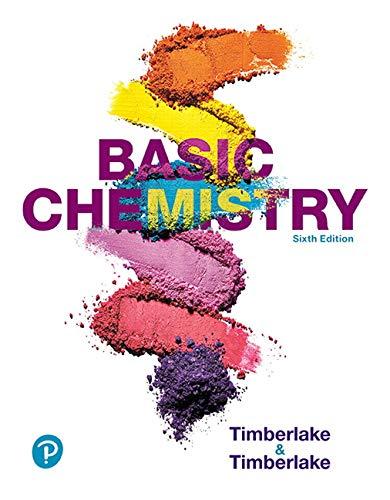
Concept explainers
(a)
Interpretation: The chemical symbol, group and period number for bromine should be written.
Concept Introduction:Elements are the substances that contain same types of atoms. All know elements are placed in the periodic table. Elements are arranged in the increasing order of their
On the basis of valence shell electronic configuration, periodic table can be classified as s, p,
(b)
Interpretation: The chemical symbol, group and period number for argon should be written.
Concept Introduction: Elements are the substances that contain same types of atoms. All know elements are placed in the periodic table. Elements are arranged in the increasing order of their atomic number.
On the basis of valence shell electronic configuration, periodic table can be classified as s, p, d and f-block elements. The number of valence shell electrons indicates the group number and the valence shell indicates the period number.
(c)
Interpretation: The chemical symbol, group and period number for Lithium should be written.
Concept Introduction: Elements are the substances that contain same types of atoms. All know elements are placed in the periodic table. Elements are arranged in the increasing order of their atomic number.
On the basis of valence shell electronic configuration, periodic table can be classified as s, p, d and f-block elements. The number of valence shell electrons indicates the group number and the valence shell indicates the period number.
(d)
Interpretation: The chemical symbol, group and period number for Radium should be written.
Concept Introduction: Elements are the substances that contain same types of atoms. All know elements are placed in the periodic table. Elements are arranged in the increasing order of their atomic number.
On the basis of valence shell electronic configuration, periodic table can be classified as s, p, d and f-block elements.
The number of valence shell electrons indicates the group number and the valence shell indicates the period number.
Want to see the full answer?
Check out a sample textbook solution
Chapter 4 Solutions
Basic Chemistry Plus Mastering Chemistry With Pearson Etext -- Access Card Package (6th Edition)
- 4.82 For each of the following, write the symbol and name for X and the number of protons and neutrons. Which are isotopes of each other? (4.4, 4.5) a. 124x A 47 b. 16x 116x 49 C. 50 d. 124x 50 116X e. 48arrow_forward28. Completely describe the orbitals found in the fourth energy level. How many electrons can be found in a full fourth energy level? Give an example of an element that has its valence electrons in the fourth energy level. (3.3) K/Uarrow_forward4.121 Complete the following table: (4.3) Namere is ONE O tong of the Element bots he Magnesium Joghe amouse. The Atomic Symbolbo 80 Se 228 F 88 Ra Number of Protons 28 Number of Neutrons 34 14 Number of Electrons Avearrow_forward
- (3.7)Classify each of the following as an atomic element, molecular element, molecular compound, or ionic compound. tin(IV) phosphide [Choose ] gold [Choose] carbon monoxide [Choose] V bromine [Choose ] < Previousarrow_forwardConsider three elements with the following abbreviatedelectron configurations: (5.4, 5.5, 5.6)X = [Ar]4s23d5 Y = [Ar]4s23d104p1 Z = [Ar]4s23d104p6a. Identify each element as a metal, nonmetal, or metalloid.b. Which element has the smallest atomic size?c. Which element has the highest ionization energy?d. Which element has a half-filled sublevel?arrow_forward20 cm3 of hydrogen peroxide solution of unknown concentration reacts completely with 12.15 cm3 0.04 mol/dm3 of potassium permanganate solution in sulfuric acid media. Calculate the mass concentration of hydrogen peroxide in g/dm3. How many cm3 (USC) of oxygen is formed? (2.07; 29.77)arrow_forward
- (6.3)The volume of a gas is 0.953 L at 30.0 °C. If the gas is heated to 60.0 °C, what would be the volume of the gas (in L) at this temperature? O 1.05 L O 0.867 L O 1.91 L O 0.477 Larrow_forward(3.6)Write the systematic names of compounds with lowercase letters except Roman Numerals. Roman number should be written with capital letters (I, II, III, IV, etc.). There should be no space between the end of the name of the metal and the parentheses with the Roman numeral. Example: CuO copper(II) oxide H₂CrO4(aq) SO3 acer H₂S(aq) FeN Sn3(PO3)2 1080arrow_forward12. Determine the number of electrons present in O (oxygen ion) when gO6 has received two electrons. The answer will be? (1.0 point)arrow_forward
- Give the symbol of the element that has the (5.6)a. largest atomic size in Period 5b. largest atomic size in Group 2A (2)c. highest ionization energy in Group 8A (18)d. lowest ionization energy in Period 2e. abbreviated electron configuration [Kr]5s24d105p2.arrow_forward7. What type of product is formed when acids are added to some ionic compounds? Stronger acids Weaker acids Gas Solids GET New version available! (3.0.220)arrow_forwardHonors Chemistry-4th Hour- Dr. Paul / Gases / Lesson 148 11. Which state of matter is most accurately described by the kinetic molecular theory? O gas aqueous solid O liquid available! (3.0.227)arrow_forward
 ChemistryChemistryISBN:9781305957404Author:Steven S. Zumdahl, Susan A. Zumdahl, Donald J. DeCostePublisher:Cengage Learning
ChemistryChemistryISBN:9781305957404Author:Steven S. Zumdahl, Susan A. Zumdahl, Donald J. DeCostePublisher:Cengage Learning ChemistryChemistryISBN:9781259911156Author:Raymond Chang Dr., Jason Overby ProfessorPublisher:McGraw-Hill Education
ChemistryChemistryISBN:9781259911156Author:Raymond Chang Dr., Jason Overby ProfessorPublisher:McGraw-Hill Education Principles of Instrumental AnalysisChemistryISBN:9781305577213Author:Douglas A. Skoog, F. James Holler, Stanley R. CrouchPublisher:Cengage Learning
Principles of Instrumental AnalysisChemistryISBN:9781305577213Author:Douglas A. Skoog, F. James Holler, Stanley R. CrouchPublisher:Cengage Learning Organic ChemistryChemistryISBN:9780078021558Author:Janice Gorzynski Smith Dr.Publisher:McGraw-Hill Education
Organic ChemistryChemistryISBN:9780078021558Author:Janice Gorzynski Smith Dr.Publisher:McGraw-Hill Education Chemistry: Principles and ReactionsChemistryISBN:9781305079373Author:William L. Masterton, Cecile N. HurleyPublisher:Cengage Learning
Chemistry: Principles and ReactionsChemistryISBN:9781305079373Author:William L. Masterton, Cecile N. HurleyPublisher:Cengage Learning Elementary Principles of Chemical Processes, Bind...ChemistryISBN:9781118431221Author:Richard M. Felder, Ronald W. Rousseau, Lisa G. BullardPublisher:WILEY
Elementary Principles of Chemical Processes, Bind...ChemistryISBN:9781118431221Author:Richard M. Felder, Ronald W. Rousseau, Lisa G. BullardPublisher:WILEY





